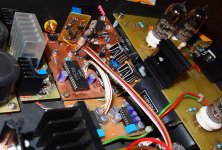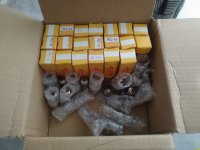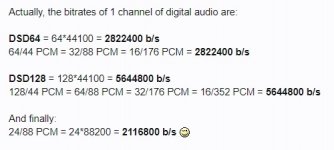Just use short cables that fit.What kind of wires I should use for this connection?
I don't know these capacitors. Never use them. Maybe I change FG on Silmic 2 later...
Guys, is there possibility to use a XLR connection and RCA (for convenience)? I mean a pseudo-balance connection for XLR cables. Is it difficult to implement?
Do not bother to change the caps...vias are too small. Your board is goo enough on your picture.
True, os-con may sound bad, but if used around digital and with good regulators there is no problem. There are regulators that do not work well with os-con due to their low ESR, especially serial. I use UKZ only for references due to low leakage current, it has nothing to do with sound but measurements. Os-con better attenuates RF interference generated by dac than other electrolytes, you can do a simple test with an oscilloscope and see for yourself.Personnaly I do not like violett SEPC. Nore the UKZ that have odd and strange short bass, plus they are better if 100V. Anyway I would avoid both. But in the Grunf layout it maybe give some compensation that sounds good in the end withbthe others devices. You have to test to know. Be aware ad1862 and pcm1702 are very different animals as well.
I have tried os-con around other dac ic ,filters and digital recivers and would always be pleased with the results.
Attachments
So we just disagree, sometimes more than often the sepc sounds bad in the digital as well, the sep are more forgiving most of the time. The sepc will fit only if your layout supports low esr, even that they are dry and thin...yes you can hear it in the digital by earing your loudspeaker... two caps that are ok with the scop do not sounds the sams whatever. At least I like to voice my dacs at the end with caps and I beleive I do because I can.
If you need low leakage then use the UKL serie in spite of the UKZ. Please try one day the United Chemicon I highligthed above.
We will agree on the good Amphom on the picture. I love all their caps, too bad they are NLA.
Your pcb job is very clean. Wanted to ask you about Ei tubes: what is Ei meaning please ? Where those ECC88 Ei were made? Herleen ?
If you need low leakage then use the UKL serie in spite of the UKZ. Please try one day the United Chemicon I highligthed above.
We will agree on the good Amphom on the picture. I love all their caps, too bad they are NLA.
Your pcb job is very clean. Wanted to ask you about Ei tubes: what is Ei meaning please ? Where those ECC88 Ei were made? Herleen ?
Ei was a factory in the former Yugoslavia, exactly in Nis, Serbia, the tubes were made under the Philips license and on their machines, so they are almost the same tubes. They have a good reputation in the EU but also in the world. Unfortunately, they are difficult to obtain and expensive today.So we just disagree, sometimes more than often the sepc sounds bad in the digital as well, the sep are more forgiving most of the time. The sepc will fit only if your layout supports low esr, even that they are dry and thin...yes you can hear it in the digital by earing your loudspeaker... two caps that are ok with the scop do not sounds the sams whatever. At least I like to voice my dacs at the end with caps and I beleive I do because I can.
If you need low leakage then use the UKL serie in spite of the UKZ. Please try one day the United Chemicon I highligthed above.
We will agree on the good Amphom on the picture. I love all their caps, too bad they are NLA.
Your pcb job is very clean. Wanted to ask you about Ei tubes: what is Ei meaning please ? Where those ECC88 Ei were made? Herleen ?
As far as electrolytes are concerned, there could be a lot of discussion, we would probably agree on something, eg UKL and UKZ are similar in leakage current, but have a different design which makes UKZ superior in audio circuits due to some other characteristics.We can talk about this for a long time, but we'd better leave it for another topic.
And thanks for the blurb for my PCB.
Attachments
Thanks.
UKZ is not a low leakags.At the opposit. It has a conservative 0,01 CV you can see in many caps.
The UKL IS a low leakage with 0,002 CV. Quite different. Numbers btw are from the datasheet.
I think you mixed with ESR. Yes the UKZ may has a little advantage over some audio caps for the esr...but not hearable. Instead his short bass is not so audio high end. You MUST use it in 100V so low uF value with something else to compensate.
UKZ is not a low leakags.At the opposit. It has a conservative 0,01 CV you can see in many caps.
The UKL IS a low leakage with 0,002 CV. Quite different. Numbers btw are from the datasheet.
I think you mixed with ESR. Yes the UKZ may has a little advantage over some audio caps for the esr...but not hearable. Instead his short bass is not so audio high end. You MUST use it in 100V so low uF value with something else to compensate.
Basically, there is a clearly audible difference between CD and Hi-Res. The prerequisite is the comparison between well recorded and real Hi-Res files and 44.1 kHz files. There are numerous outputs that are merely upsampled. It is always worthwhile to look at the spectrum of the recording with a software tool. In my opinion, 96 kHz (still a doubling of the Nyquest frequency) is sufficient, which leaves room for improvement. Higher resolutions quickly become a kind of data grave, but have their raison d'être if someone follows a special temporary upsampling/software filter concept. With suitable player software. Or even if you want to test this in conjunction with hardware filters on your NOS DAC. My recommendation: Faith does not help here! Test yourself if it is good for you.Does anyone compare a different frequences (44,1KHz, 96Khz, 192Khz) on the same music? - is there a difference between CD and Hi-Res?
I have a few hybrid SACD disks and difference between CD layer and SACD is noticeable. SACD have more warm, volume of the scene and more realistic voice. I listen on my Denon 3910. The other thing - is that music on SACD is boring (jazz, blues, old rock) - I like a modern styles.Basically, there is a clearly audible difference between CD and Hi-Res.
For those that asked about this, I've made a few tweaks and ordered another set of boards. Once I've tested those and am happy, I'll post the gerbers here.I made a little Zen IV board with simple 317/337 PSU for my miro dac. Just wanted to make something small and self-contained. This was my first go at a discrete IV implementation, and I'm really loving the sound. The boards need a couple small revisions (namely the jfet silkscreens need rotated 180deg) – if anyone has other improvements I could make, let me know (I'm a complete novice so won't be offended 🙂 Thinking I'll do a discrete diode version for the PSU next go around. After that, I want to explore some of EUVL's IV solutions.
I did the measurements according to the instructions of Walt Jung and UKZ proved to be excellent in terms of leakage current, I tested about twenty types of various caps, for example os-con have about 100 times higher value and Panasonic FC or Rubycon ZLJ are quite close to UKZ.Thanks.
UKZ is not a low leakags.At the opposit. It has a conservative 0,01 CV you can see in many caps.
The UKL IS a low leakage with 0,002 CV. Quite different. Numbers btw are from the datasheet.
I think you mixed with ESR. Yes the UKZ may has a little advantage over some audio caps for the esr...but not hearable. Instead his short bass is not so audio high end. You MUST use it in 100V so low uF value with something else to compensate.
An Improved Reference Filter for Audio Regulators
My current Dac is not support through usb 88 and above. Only 44-48Khz. He have a cheap CS8416 and trough coaxial 44-192 but I can't connect like that 😀You could also rip sacd to iso or single dsf-files. And convert i.e. to 88,2 kHz/24Bit PCM.
Hello.
I am planning to have room end point using RPI.But Rpi4 is not available now then found Allo sparky SBC and Kali reclocker.
My question is how can I connect with ad1862 DAC board and if it's worth to build?
https://diyaudiocart.com/ALLO-KALI-RECLOCKER
I am planning to have room end point using RPI.But Rpi4 is not available now then found Allo sparky SBC and Kali reclocker.
My question is how can I connect with ad1862 DAC board and if it's worth to build?
https://diyaudiocart.com/ALLO-KALI-RECLOCKER
Hi,
That is a good idea as it is a denoised rpi to say it short and the Kali is a good reclocker we talked several times in the thread. You just need a Miro pcb and use the shift registers on it, then connect the kali with 3 short 5 to 10 cm max wires for I2S and a last for ground. Conections are shown and both the datasheet scheme of the Miro ad 1862 board and the Kali Allo one.
That is a good idea as it is a denoised rpi to say it short and the Kali is a good reclocker we talked several times in the thread. You just need a Miro pcb and use the shift registers on it, then connect the kali with 3 short 5 to 10 cm max wires for I2S and a last for ground. Conections are shown and both the datasheet scheme of the Miro ad 1862 board and the Kali Allo one.
Been picking at this thread, thanks for all the hard work developing this project.
Is there an easy way to get balanced operation, either by configuring these boards or getting an inverted data stream from the JLsounds module? I've been looking in a few places but I don't see any mention of the functionality (if it exists)
Is there an easy way to get balanced operation, either by configuring these boards or getting an inverted data stream from the JLsounds module? I've been looking in a few places but I don't see any mention of the functionality (if it exists)
This is how we did balanced -- inverter on the DATA line just before the DACs.
https://www.diyaudio.com/community/...st-tht-i2s-input-nos-r-2r.354078/post-6925148
Essentially same approach as Pass D1 / Spencer D1 Clone using 1x 74HC86 (or equivalent) per channel :
http://www.fetaudio.com/archives/23
Patrick
https://www.diyaudio.com/community/...st-tht-i2s-input-nos-r-2r.354078/post-6925148
Essentially same approach as Pass D1 / Spencer D1 Clone using 1x 74HC86 (or equivalent) per channel :
http://www.fetaudio.com/archives/23
Patrick
Guys, I'm building the PSU-1 for Dac and I have a question - where 4 pcs (1N4007G diodes)are located on board? Also I would ask to take a close photo PSU-1 (if it's not too difficult) for me. I couldn't find Wima mkp2 (0,33/100) but instead will be mkp10 of the same denomination. Also I change metal film resistors on carbon film (CF-1/2W-1KJ - example). It's okay?
Now I have Dodson DA-217 mk2d (2 x PCM1704-K). He is same level like Levinson 360s. He's away for a week. I can tell you that it plays very maturely. Unfortunately I can't compare it with Miro's Dac. I will compare from memory later 🙂
My sources - PC with optical and Akai CD-79 as transport for Dodson.
Now I have Dodson DA-217 mk2d (2 x PCM1704-K). He is same level like Levinson 360s. He's away for a week. I can tell you that it plays very maturely. Unfortunately I can't compare it with Miro's Dac. I will compare from memory later 🙂
My sources - PC with optical and Akai CD-79 as transport for Dodson.
Attachments
I m not sure the mkp10 size is the same as mkp2.
carbon film resistor are ok
In psu1 I would avoid any film cap at the output of the reg and just will do with 47 to 220 uF with not low ESR cap choice. Mkp or mkt are still mandatory at the input of the cap but here also a little panasonic FC of few uF with 2,5 mm leads pitch directly soldered across the IN & Gnd pin of the 78012/05 will makes the trick as well.
carbon film resistor are ok
In psu1 I would avoid any film cap at the output of the reg and just will do with 47 to 220 uF with not low ESR cap choice. Mkp or mkt are still mandatory at the input of the cap but here also a little panasonic FC of few uF with 2,5 mm leads pitch directly soldered across the IN & Gnd pin of the 78012/05 will makes the trick as well.
Mkp10 - 15mm, mkp2-5mm. I'm couldn't find mkp2. Do you think electrolyte will be better instead cap in that case?I m not sure the mkp10 size is the same as mkp2.
carbon film resistor are ok
In psu1 I would avoid any film cap at the output of the reg and just will do with 47 to 220 uF with not low ESR cap choice. Mkp or mkt are still mandatory at the input of the cap but here also a little panasonic FC of few uF with 2,5 mm leads pitch directly soldered across the IN & Gnd pin of the 78012/05 will makes the trick as well.
I'm just going by the list . Do you know about four diodes? - their location?
- Home
- Source & Line
- Digital Line Level
- DAC AD1862: Almost THT, I2S input, NOS, R-2R



